Turbomolecular Pump Market Size
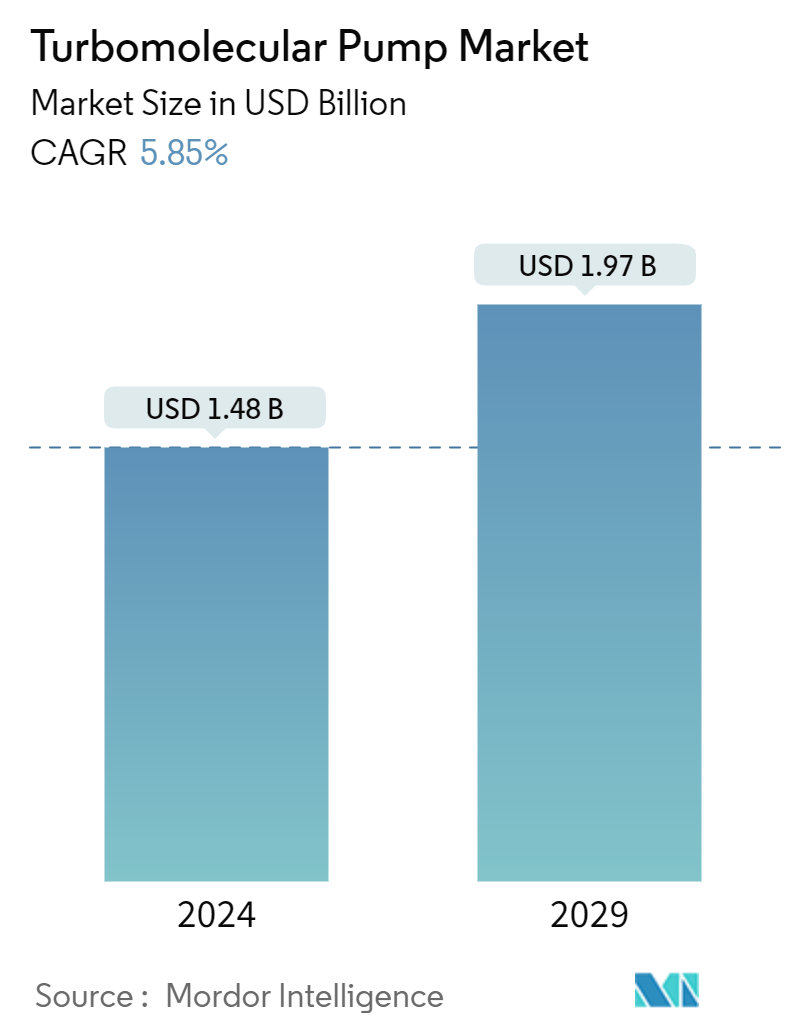
| Study Period | 2019 - 2029 |
| Market Size (2024) | USD 2.25 Billion |
| Market Size (2029) | USD 2.99 Billion |
| CAGR (2024 - 2029) | 5.85 % |
| Fastest Growing Market | North America |
| Largest Market | Asia Pacific |
| Market Concentration | Low |
Major Players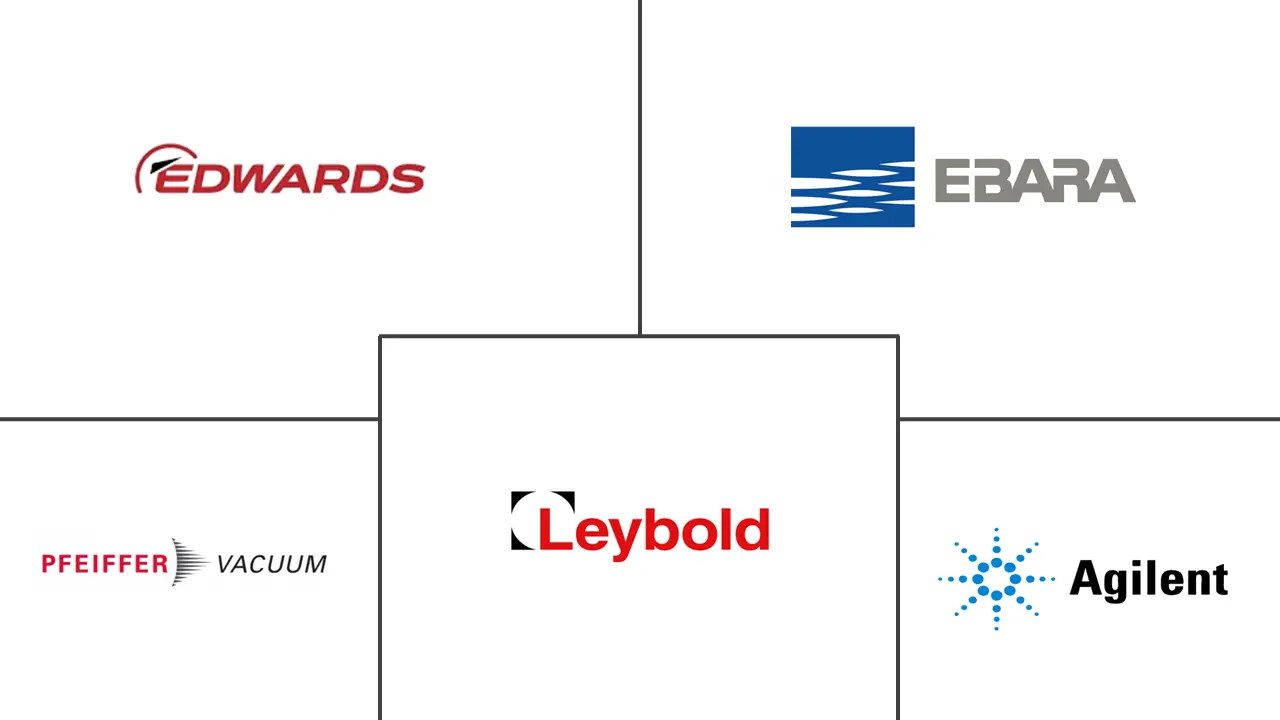
*Disclaimer: Major Players sorted in no particular order |
Turbomolecular Pump Market Analysis
The Turbomolecular Pump Market size is estimated at USD 1.48 billion in 2024, and is expected to reach USD 1.97 billion by 2029, growing at a CAGR of 5.85% during the forecast period (2024-2029).
- Turbomolecular pumps utilise a rapidly spinning rotor, typically rotating between 24,000 and 90,000 rpm, to create a kinetic vacuum. Various industries have driven substantial growth in the turbo molecular pumps market. With the rise in consumer electronics, AI, IoT devices, and 5G, demand for semiconductors is at an all-time high, driving the demand for high-efficiency vacuum pumps. As electronic components become portable and more complex, the semiconductor manufacturing process requires ultra-clean and high-vacuum environments, making turbomolecular pumps crucial for producing microchips and wafers.
- The companies are expanding research and development activities in life sciences, materials science, and nanotechnology, further boosting demand for turbomolecular pumps. Instruments such as electron microscopes and spectrometers, essential in research and diagnostics, require turbomolecular pumps' ultra-high vacuum (UHV) environment. The increasing use of these instruments in pharmaceuticals, biotechnology, and scientific research is a significant demand driver.
- The need for high-quality coatings in various industries, such as tooling, cutting, and machinery, further boosts the demand for turbomolecular pumps. Advanced coating technologies for engine components, turbine blades, and other parts require high-vacuum conditions, increasing the demand for turbomolecular pumps in automotive and aerospace engineering. Moreover turbomolecular pumps are used in testing chambers that simulate space conditions for satellite and spacecraft components, a growing market due to the expansion of the space exploration and satellite industry.
- Turbomolecular pumps are highly specialised and technologically advanced, leading to high initial capital investment. This can deter small and medium-sized enterprises (SMEs) from adopting these pumps, especially in cost-effective industries. Furthermore, turbomolecular pumps require regular maintenance despite their efficiency, and repairs can be costly due to the precision and complexity of their components. Downtime during maintenance can also affect the production schedules, further discouraging the adoption.
- Macroeconomic factors like rising electricity prices can increase the operational costs for end-users as turbomolecular pumps are energy-intensive. Companies may opt for more energy-efficient alternatives in regions with high energy costs, reducing the demand for turbomolecular pumps. Since turbomolecular pumps are used extensively in the semiconductor manufacturing industry, the global chip shortage can reduce production capacity and demand for semiconductor manufacturing equipment, including turbomolecular pumps.
Turbomolecular Pump Market Trends
Semiconductor Manufacturing is Expected to Witness a Significant Growth
- Semiconductor manufacturing requires ultra-high vacuum environments to ensure materials' precise deposition and etching onto wafers. Turbomolecular pumps are essential in creating these vacuum conditions, critical for producing high-performance, defect-free semiconductors. Turbomolecular pumps are ideal for semiconductor fabs where any contamination, including oil particles, could compromise the quality of microchips. This demand for clean vacuum environments significantly drives the adoption of turbomolecular pumps.
- With the increasing demand for chips across automotive, consumer electronics, telecommunications, and industrial automation industries, semiconductor manufacturers are expanding their production. This drives the demand for advanced vacuum systems, including turbomolecular pumps, to scale up fabrication facilities. As semiconductor manufacturers integrate more downstream operations like assembly, testing, and packaging within the facilities, the need for turbomolecular pumps extends beyond fabrication. These pumps are used in various supply chain stages to maintain vacuum integrity, enhancing demand across the entire semiconductor production process.
- With the rise of advanced packaging technologies like 3D integrated circuits (ICs) and wafer-level packaging, the semiconductor industry requires more precise vacuum environments for bonding and encapsulation processes. Turbomolecular pumps help maintain the necessary vacuum conditions for these high-precision processes, further driving the significant demand for these pumps.
- To improve chip performance, the semiconductor industry uses new materials like gallium nitride (GaN), silicon carbide (SiC), and other advanced compounds. These materials often require specialized manufacturing environments, including ultra-high vacuum systems supported by turbomolecular pumps, which boost the demand in research and development settings. In addition, the demand for memory chips, such as DRAM and NAND, has seen exponential growth due to data centres, cloud computing, and consumer electronics. Memory chip production also involves vacuum-based processes like thin-film deposition and ion implantation, where turbomolecular pumps are essential for ensuring process stability and accuracy.
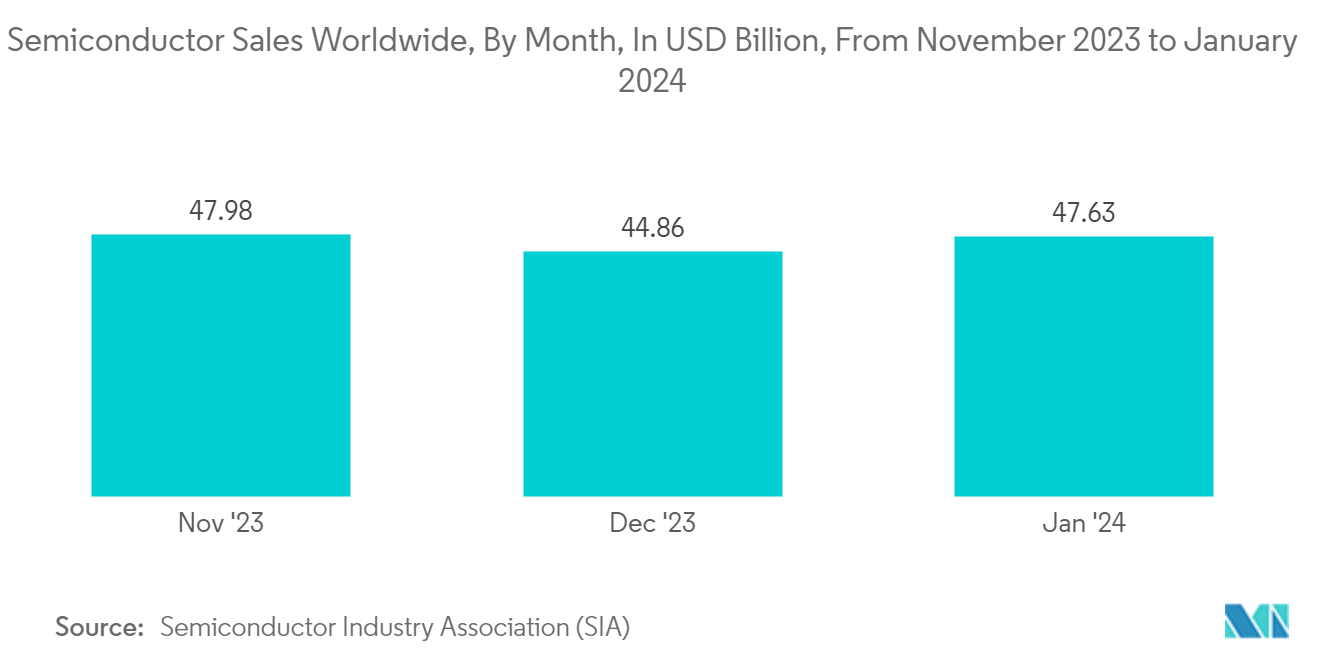
Asia Pacific is Expected to Hold a Significant Market Share
- Asia Pacific region is witnessing substantial investments in new semiconductor fabrication plants (fabs), especially for advanced nodes like 7nm, 5nm, and smaller. These fabs require extensive vacuum systems for manufacturing, fueling the demand for turbomolecular pumps. In August 2024, over the next five to 10 years, L&T Semiconductor Technologies (LTSCT) plans to establish three semiconductor fabs in India, with potential investments ranging from USD 10 to 12 billion. This move underscores the L&T group's ambition to evolve its newest business vertical into a global semiconductor contender.
- Asia Pacific (APAC) is a significant hub for consumer electronics manufacturing, with countries like China, Japan, and South Korea leading production. As consumer electronics, such as smartphones, laptops, and wearables, evolve with more complex features, the need for precise vacuum processes increases, driving the demand for turbomolecular pumps. According to NBC (National Bureau of Statistics of China), China's retail sales of household appliances and consumer electronics exceeded CNY 73 billion (USD 10.38 billion) in July 2024.
- Many regional governments are prioritising the development of high-tech industries, such as semiconductors, renewable energy, and biotechnology. Supportive policies, tax incentives, and infrastructure investments are encouraging the growth of these sectors, leading to an increased demand for turbomolecular pumps. In addition, industries like chemicals, coatings, and materials processing rely on vacuum technologies for various applications, contributing to the growth of turbomolecular pumps in the Asia Pacific region.
- As countries in Asia Pacific transition to renewable energy sources and invest in electric vehicle production (EV), the demand for batteries is increasing. Manufacturing these batteries involves vacuum processes for coating and material deposition, driving the demand for turbomolecular pumps. In January 2024, the China Association of Automobile Manufacturers announced that China's automobile industry achieved a remarkable milestone, with production and sales surpassing 30 million units annually. This indicates the immense growth potential of the automobile market, driving the demand for the pumps.
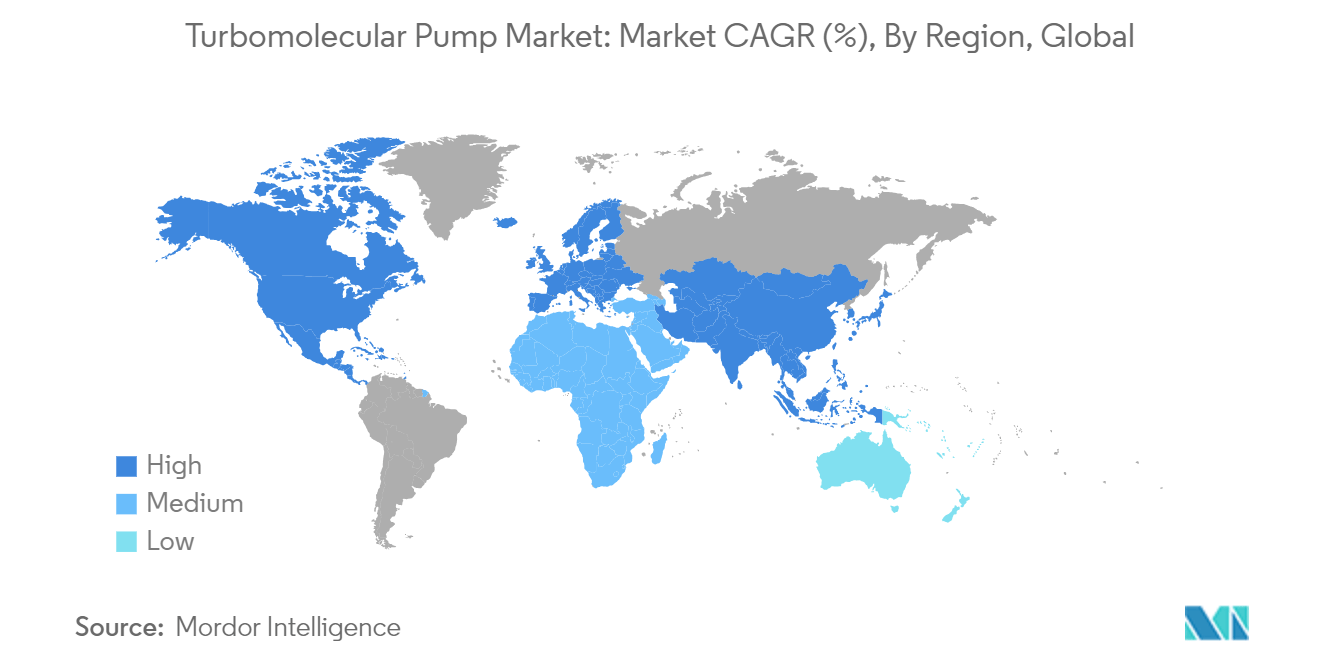
Turbomolecular Pump Industry Overview
The turbomolecular pump market is highly fragmented, with global conglomerates and specialised players operating across various segments. While several large multinational companies dominate specific high-value segments, numerous regional and niche players contribute to the overall competition, making the market highly diverse. This fragmentation is driven by the wide range of applications for turbomolecular pumps, allowing both large and small companies to coexist and thrive in the market.
Leading companies in the turbomolecular pump market include Edwards Vacuum, Ebara Corporation, Busch, Pfeiffer Vacuum, and Agilent Technologies. These companies have established strong brand recognition and extensive global operations, enabling them to command significant market share. Their strengths lie in innovation, broad product portfolios, and strong distribution networks. These leaders often engage in strategic acquisitions and partnerships to maintain their competitive edge and expand their market reach.
To succeed in the turbomolecular pump market, companies must prioritise innovation, especially in energy efficiency and environmental sustainability. As industries increasingly demand greener solutions, the development of eco-friendly turbomolecular pumps could become a significant differentiator. Additionally, expanding service offerings and enhancing customer support will be crucial for maintaining long-term relationships and securing repeat business. Companies that invest in emerging markets and adapt their products to regional needs are likely to gain a competitive advantage in this fragmented market.
Turbomolecular Pump Market Leaders
-
Edwards Vacuum
-
Ebara Corporation
-
Pfeiffer Vacuum GmbH
-
Leybold GmbH
-
Agilent Technologies
*Disclaimer: Major Players sorted in no particular order
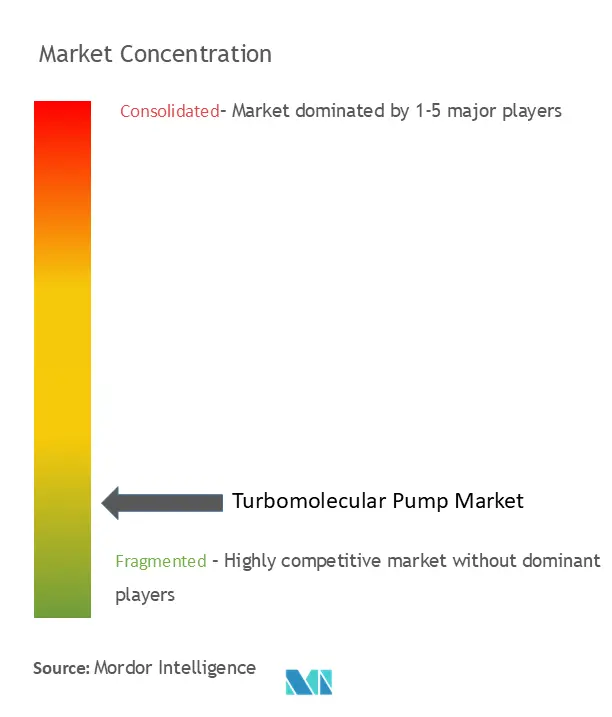
Turbomolecular Pump Market News
- May 2024: Pfeiffer Vacuum and Busch Denmark collaborated to host a Vacuum Day at the Technical University of Denmark (DTU) in Copenhagen. This event offered participants a deep dive into fundamental technologies for vacuum generation and measurement alongside practical applications of these products in experiments. For instance, participants discovered the straightforward maintenance process of Pfeiffer Vacuum's HiPace turbomolecular vacuum pump and HiScroll vacuum pumps. A key highlight was the discussion on energy savings made possible by the innovative HiScroll fitting.
- March 2024: Pfeiffer Vacuum's HiCube Neo vacuum pumping station, boasting pumping speeds from 80 to 800 l/s, is designed for high and ultra-high vacuum applications. The HiCube Neo's versatility shines through its compatibility with various backing pumps, including diaphragm, rotary vane, scroll, and multi-stage Roots pumps. This adaptability positions the turbo pumping station as an ideal choice for both industrial and research & development applications. Typical applications encompass gas analysis, vacuum gauge calibration, cryostat pumping, and operation in vacuum furnaces. Whether as a compact desktop solution or a standalone unit, the HiCube Neo seamlessly meets diverse requirements.
Turbomolecular Pump Market Report - Table of Contents
1. INTRODUCTION
1.1 Study Assumptions and Market Definition
1.2 Scope of the Study
2. RESEARCH METHODOLOGY
3. EXECUTIVE SUMMARY
4. MARKET INSIGHTS
4.1 Market Overview
4.2 Industry Attractiveness - Porter's Five Forces Analysis
4.2.1 Bargaining Power of Suppliers
4.2.2 Bargaining Power of Consumers
4.2.3 Threat of New Entrants
4.2.4 Threat of Substitute Products
4.2.5 Intensity of Competitive Rivalry
4.3 Industry Value Chain Analysis
4.4 Impact of COVID-19 Aftereffects and Other Macroeconomic Factors on the Market
5. MARKET DYNAMICS
5.1 Market Drivers
5.1.1 Technological Advancements in Vacuum Pump Systems
5.1.2 Expansion of Research and Development and Laboratory Applications
5.2 Market Restraint
5.2.1 Maintenance and Operational Costs
6. MARKET SEGMENTATION
6.1 By Product Type
6.1.1 Oil-Lubricated
6.1.2 Hybrid Turbomolecular Pumps
6.1.3 Magnetically Levitated
6.1.4 Air-cooled Turbomolecular Pumps
6.2 By Application
6.2.1 Analytical Instrumentation
6.2.2 Industrial Vacuum Processing
6.2.3 Research and Development
6.2.4 Semiconductor Manufacturing
6.2.5 Others
6.3 By Geography***
6.3.1 North America
6.3.2 Europe
6.3.3 Asia
6.3.4 Australia and New Zealand
6.3.5 Latin America
6.3.6 Middle East and Africa
7. COMPETITIVE LANDSCAPE
7.1 Company Profiles
7.1.1 Edwards Vacuum Ltd.
7.1.2 Ebara Corporation
7.1.3 Pfeiffer Vacuum GmbH
7.1.4 Leybold GmbH
7.1.5 Agilent Technologies
7.1.6 Busch Group
7.1.7 ULVAC Technologies Inc.
7.1.8 Shimadzu Corporation
7.1.9 Osaka Vacuum Ltd.
7.1.10 KYKY Technology CO., LTD.
- *List Not Exhaustive
8. INVESTMENT ANALYSIS
9. FUTURE OF THE MARKET
Turbomolecular Pump Industry Segmentation
The Turbomolecular Pumps are a significant choice for achieving high vacuum pressures. User-friendly and demanding less maintenance than diffusion pumps, these pumps offer several advantages. Their compact size eliminates the need for water cooling and swiftly attains the desired vacuum level. Furthermore, they ensure a high level of purity. Capable of operating across a rough vacuum, high vacuum, and Ultra-High Vacuum (UHV) ranges, Turbomolecular pumps maintain a consistent pumping speed of up to 4000 litres per second.
The study tracks the revenue accrued through the sale of turbomolecular pump types by various players globally. The study also tracks the key market parameters, underlying growth influencers, and major vendors operating in the industry, which supports the market estimations and growth rates over the forecast period. The study further analyses the overall impact of COVID-19 aftereffects and other macroeconomic factors on the market. The report's scope encompasses market sizing and forecasts for the various market segments.
The turbomolecular pump market is segmented by product type (oil-lubricated, hybrid turbomolecular pumps, magnetically levitated, and air-cooled turbomolecular pumps), application (analytical instrumentation, industrial vacuum processing, research and development, semiconductor manufacturing, and others), and geography (North America, Europe, Asia-Pacific, Latin America, and Middle East and Africa). The market sizes and forecasts are provided in terms of value (USD) for all the above segments.
| By Product Type | |
| Oil-Lubricated | |
| Hybrid Turbomolecular Pumps | |
| Magnetically Levitated | |
| Air-cooled Turbomolecular Pumps |
| By Application | |
| Analytical Instrumentation | |
| Industrial Vacuum Processing | |
| Research and Development | |
| Semiconductor Manufacturing | |
| Others |
| By Geography*** | |
| North America | |
| Europe | |
| Asia | |
| Australia and New Zealand | |
| Latin America | |
| Middle East and Africa |
Turbomolecular Pump Market Research FAQs
How big is the Turbomolecular Pump Market?
The Turbomolecular Pump Market size is expected to reach USD 2.25 billion in 2024 and grow at a CAGR of 5.85% to reach USD 2.99 billion by 2029.
What is the current Turbomolecular Pump Market size?
In 2024, the Turbomolecular Pump Market size is expected to reach USD 2.25 billion.
Who are the key players in Turbomolecular Pump Market?
Edwards Vacuum, Ebara Corporation, Pfeiffer Vacuum GmbH, Leybold GmbH and Agilent Technologies are the major companies operating in the Turbomolecular Pump Market.
Which is the fastest growing region in Turbomolecular Pump Market?
North America is estimated to grow at the highest CAGR over the forecast period (2024-2029).
Which region has the biggest share in Turbomolecular Pump Market?
In 2024, the Asia Pacific accounts for the largest market share in Turbomolecular Pump Market.
What years does this Turbomolecular Pump Market cover, and what was the market size in 2023?
In 2023, the Turbomolecular Pump Market size was estimated at USD 2.12 billion. The report covers the Turbomolecular Pump Market historical market size for years: 2019, 2020, 2021, 2022 and 2023. The report also forecasts the Turbomolecular Pump Market size for years: 2024, 2025, 2026, 2027, 2028 and 2029.
Turbomolecular Pump Industry Report
Statistics for the 2024 Turbomolecular Pump market share, size and revenue growth rate, created by Mordor Intelligence™ Industry Reports. Turbomolecular Pump analysis includes a market forecast outlook for 2024 to 2029 and historical overview. Get a sample of this industry analysis as a free report PDF download.



